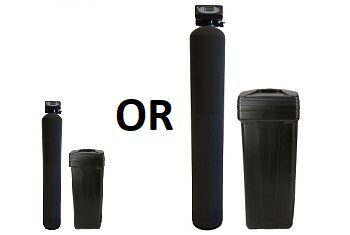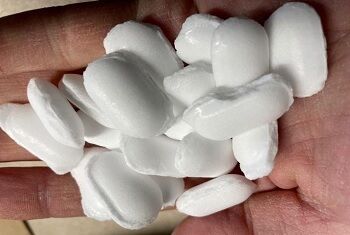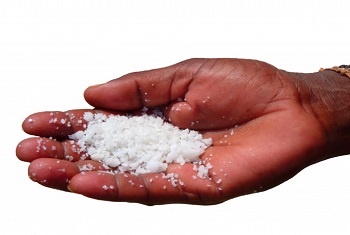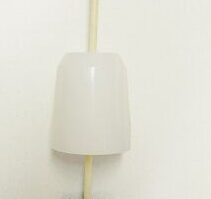UPDATED: February 19, 2023
You have always had to add a bag of water softener salt to your water softener brine tank every month. But lately, it seems that you have been adding salt more often than before. Your water softener is just a few years old, what could be wrong?
A rise in salt usage by a water softener is due to an increase in water usage, the settings of the water softener changed, there being too much water in the salt tank, or the water softener control valve malfunctioning.
There are a few reasons that your water softener may be using more salt than it used to. Let’s see if we can pinpoint what is happening that is making your water softener use so much salt.
What is causing your water softener to use more salt than it used to?
There could be many things that can cause your water softener to use more salt than it used to, let’s check a few reasons that could cause more salt usage than usual.
- Increased Water Demand
- Running Toilets, Dripping Sinks, Running Spigots, Leaking Pipes
- New Water Softener Is Bigger Or Smaller Than Old One
- Change In the Type Of Salt Used
- Brine Tank Float Out Of Adjustment
- Clogged Water Softener Injector/Venturi
- Water Softeners Clock Set Incorrectly
- Leaking Seals In Your Water Softeners Control Valve
- Lower Water Softener Resin Efficiency
- Power Outage
How Much Salt Should Your Water Softener Be Using?
Use this simple water softener salt usage estimator to see approximately how much salt your water softener SHOULD be using.
Water Softener Salt Usage Calculator
Not sure what your Total Water Hardness is? Check out my article “What Should My Water Softener Hardness Be Set At?” to find out!
Now let’s find out why your water softener is using so much salt!
Are you using more water than you used to?
Most water softeners have the ability to meter the water being used in the home, and only regenerate when needed based on how much water is used.
If there are additional people living in the house, then there will be more water being used, and therefore, the water softener will regenerate more often, and more salt will be needed.
Have your children come home from college, is there a new baby in the house, or maybe a guest is staying with you? Any of these circumstances will mean that the amount of water being used in the home has increased.
Having just 1 additional person living in the home can add about 70 additional gallons of water to your average daily water needs. One person uses water from many sources in the home that add to the amount of salt that your water softener will need to use for your average daily water usage.
Here’s a breakdown of the average water consumption per person per day in an average American home according to EPA statistics.
| Type Of Water Use | Average Usage Per Day, Per Person | % Of Total Water Used |
|---|---|---|
| Toilet Usage | 18.5 | 26.7 |
| Washing Clothes | 15.0 | 21.7 |
| Showering | 11.6 | 16.8 |
| Sink Faucets | 10.9 | 15.7 |
| Water Leaks | 9.5 | 13.7 |
| Other | 1.6 | 2.2 |
| Bathing | 1.2 | 1.7 |
| Dish Washer | 1.0 | 1.4 |
| Total: | 69.3 Gallons | 100% |
Check for running toilets, leaking faucets, and even outside spigots.
Just because you are not deliberately using water, doesn’t mean there is no water being used!
A faucet that is dripping slightly may not seem like a big deal, but during the course of a day, that drip could equate to several gallons of water that your water softener is registering, which will make your water softener regenerate more often than it did before the leak.
If you have a faucet that drips, a toilet that is constantly trickling, and an outside spigot that just doesn’t want to shut off completely, that can add up to a whole lot of water being wasted that will make your water softener go through more salt.
New Water Softener Is Bigger Or Smaller Than Old One.

Since the amount of salt that a water softener needs to regenerate the water softener resin in its resin tank(s) is generally relevant to the amount of water softener resin that is being regenerated, a larger water softener with more resin will use more salt per regeneration than a smaller water softener with less resin.
For more about how the size of a water softener makes a difference, see my article “Can A Water Softener Be Too Big?”
If you are used to seeing a drop in the amount of salt in your old water softener brine tank every week and now you have a larger capacity water softener, you may not see your salt go down as often as you are used to but the amount that the salt drops will be grater which may appear that you are using more salt than before.
On the other hand, if you have replaced your old water softener with a smaller capacity water softener you will tend to see that the salt goes down more often than before which could look like you are using more salt in your new water softener than you did with your old one.
Are You Using A Different Type Of Salt Than You Used To?
There are several different brands and forms of water softener salts available and they don’t all work exactly the same.
If you normally use a certain brand and type of water softener salt that contains many impurities that causes it to not dissolve efficiently and then you change to a very pure salt that contains fewer impurities, you may find that more of the pure salt gets dissolved in your brine tank.
Also, a larger-sized salt crystal may dissolve slower than a finer-sized crystal.


Given enough time, the amount of salt dissolved would be the same despite the size of the salt crystal, if your water softener regenerates often, the larger-sized piece of salt may not have enough time to dissolve compared to a smaller-sized piece of salt.
See my article about Pellet salt and Crystal salt and which one should you use for your water softener.
Your water softener brine float may be out of adjustment.
This is most common with NON-Electric water softeners that use the brine float on their brine float assemblies to regulate how much water should be put into the brine tank which dictates how much salt will be used per regeneration.

These brine floats can gradually come out of adjustment due to the water pressing them up each time the level of water in the brine tank reaches the float.
Over time the float can become significantly higher than originally set which means that your brine tank can become full of water and your water softener will use more salt than needs to or be used to.
You could have a clogged injector/venturi!

The injector (sometimes called venturi) is a restrictor that creates a vacuum to draw the brine from the salt tank. The water softener needs brine to remove the existing hardness from the water-softening resin in its tank.
If the injector gets clogged or develops a build-up of iron or other minerals on it, it will not be able to create a strong enough draw and may leave water behind in the salt tank.
When the water softener reaches the brine tank fill cycle, it will put a pre-determined amount of water into the salt tank.
If there is water in the salt tank that has been left over, the level of the water will be higher than before. This means more salt can be dissolved.
This problem can be resolved by cleaning the injector with an iron cleaner or replacing the injector with a new one. Often just a cleaning using iron cleaner and an old toothbrush will work just fine.
Once the injector is working correctly, the water softener should use all of the brine in the salt tank, and the amount of salt dissolved should be back to normal.
Is the clock on your water softener set correctly?
If your water softener regenerates when there is water being used elsewhere in the home, it might not have enough water pressure to draw all of the brine from the salt tank.
When this happens, the water softener will add water to the salt tank, and if water has been left behind, there will be more water in the tank than normal, and therefore more salt can be dissolved.
A water softener should operate when there is no, or little water being used in the home. Your water softener should be set to regenerate at 2:00 am as long as the clock is set to the correct time.
Most water softeners have similar buttons as an everyday digital clock, just set the correct time on your water softener, and it should regenerate at 2:00 am when most people are fast asleep.
There may be water flowing through your water softeners’ control valve.
Most water softeners use a control valve that has a piston that moves back and forth to control the water flow in order for the water softener to run through its cycles.
This piston moves through a rubber, or other water-stopping series of seals that isolate the different chambers in which the water needs to flow for each regeneration cycle.
Over time, these seals can get worn and allow water to get past them. When this happens, the water can run through the control 24 hours a day.
Even a small leak inside the control valve can waste several gallons of water per day. This wasted water can quickly add up and cause the water softener to regenerate more frequently than it used to.
Replacing this piston and seal can be done yourself, but unless you are handy at plumbing-type stuff, I recommend calling your water treatment professional to replace the piston and seals.
If you would like to try it yourself, you can get many common water softener pistons and seals here.
If you suspect that you are using more salt in your water softener than you should be, or if you are using much more than you used to, check for these possible causes, and you should get your water softener using the correct amount of salt.
Lower Water Softener Resin Efficiency
Over time, water softener resin can become less efficient at removing hardness from your water. As the efficiency of water softener resin decreases, your water softener may need to use more salt to regenerate the water softener resin more thoroughly.
Although your water softener could be set correctly for your water hardness, you may need to increase the water hardness setting on your water softener to compensate for your water softener resins loss of efficiency.
Have you had a power outage recently?
Most programmable water softeners need to be set for your particular water characteristics when they are installed.
Your water hardness and iron content are programmed into the water softener so that it knows how often to use salt to regenerate.
Even though most programmable water softeners have a small battery in them to retain the programming of the computer, these batteries don’t last forever.
After a few years, the backup battery will no longer retain the system’s programming. This means that if you have even a brief power outage, your water softener may lose its program settings.
Often, a programable water softener will have a factory pre-set hardness, usually 20.
If your water hardness is about 20, to begin with, you may never even notice that your settings have changed at all.
But if your system was set for a water hardness of 10 before losing its programming, it will now regenerate twice as often, and use twice as much salt.
Reprogramming your water softener is usually pretty easy.
Just get yourself a simple water hardness test kit to determine the hardness of your water, and then enter the hardness amount into your water softener’s computer as your instruction manual says. The water softener will figure out the rest.
If you have a history of iron in your water, get a more complete water test kit to test for your water hardness as well as the level of iron in your water.
For every 1 part per million (PPM) of iron in your water, add 4 to the hardness number. This will give you the final number to put into your water softener programming to remove the hardness as well as the iron.
I recommend programming your water hardness just a little bit higher than the actual number that it is to allow for fluctuations in your water.
Adding about 20% of the number should be just fine. So if your hardness and iron equate to 20, put in 24 to be safe.
Watch this quick video on programming the Fleck 5600 SXT water softener. A very popular model.
The most common size of water softener holds 1 cubic foot of water-softening resin in its tank. To efficiently regenerate 1 cubic foot of resin, a properly working water softener needs to use 6 to 8 pounds of salt.
This means that a standard-sized 40-pound bag of water-softening salt should be enough for 5 to 6 regenerations.
So if your water softener needs to regenerate once per week, you should only have to add one 40-pound bag of water softener salt per month.
For example, A family of four each uses 75 gallons of water per day (300 gallons per day). The total hardness of the water is 10, and they are using a water softener with one cubic foot of water softener resin in it (the most common size).
At 300 gallons per day with 10 grains of hardness per gallon, it will have to remove 3000 grains of hardness per day.
Since a water softener with one cubic foot of water softening resin will efficiently remove about 24000 grains of hardness per regeneration, the water softener will have to regenerate at least once every 8 days to provide soft water to the family.
Since we don’t want to risk having hard water staining the water fixtures of the home, the water softener should be set so that it regenerates every 7 days rather than 8 days in case there is high water usage on the 8th day.
To Sum Up:
In most cases, an increase in salt usage by a water softener is due to an increase in water usage.
Additional activity in the home, the addition of people in the home, people being home more than before, and the addition of water being used by appliances, toilets, and faucets often explain the increase in water consumption which leads to an increase in salt usage by a water softener.
If water usage in the home has NOT changed, an increase in salt usage by a water softener is often due to the water softener functioning differently than it did previously.
Checking the probable causes of your water softener using too much salt discussed in this article will often lead you to discover the cause and a solution to the problem.


Hi
I have brand new monarch water softener and it’s using far to much salt a bag every three weeks.
There is two of us in the house. I have had the engineer around three time and and no joy in resolving the problems.
There is no leaks in the system.
I have noticed there is water in the tank when I’m refilling.
Any advice would be helpful.
Regards
Yash Nanda
Hello Yash and thank you for the question.
If your water softener has been set correctly, it should only regenerate when you have used a pre-determined amount of water. This will depend on how hard your water is, if there is any iron in your water, and how much water you are using.
Just an example, a family of 4 adults using water that has 20 grains per gallon of hardness in it may use 1 forty pound bag of salt per week, but a single person using water that has a hardness of only 5 may use one bag every 2 months.
If your service person has verified that the system is set correctly and you are using 1 bag every three weeks regularly, it may be working just fine. Ask your service person to calculate the number of gallons of water that your system should be able to soften between regenerations, and then see if you are using close to that amount of water between regenerations.
I hope this was helpful.
Paul
water softner is about 20 years old seem like addmore water salt more often every 3 months not sure is old replace dont really have a person that I know come look at it
Hello Judy and thank you for the question.
The fact that the water softener is 20 years old does not mean that it will use more salt.
I would check for an increase in your water usage as this will trigger your water softener to regenerate more often.
Check for toilets that do not shut off correctly, leaking faucets, or increased water usage by people in the home.
If you can’t find any reason for more water being used, you could contact a reputable plumber to test your water and make sure that it is set correctly.
I hope this was helpful.
Paul
My water softener does not refill itself. What is wrong? We have to pour water into the tank.
Hello Greg and thank you for the question.
Without knowing what brand and model water softener that you have, I can’t be sure what to look for but if you have a standard electric water softener, I would check for blockage in the bottom of the brine tank, debris behind the brine valve in the valve or for a sticking brine float in the brine tank.
If you have a digital water softener, check that the “Brine Fill” is set correctly. I will often be set for about 4 minutes.
If there is blockage at the bottom of the white brine tube, the water softener may still be able to draw the brine out because it may draw the brine for up to 90 minutes where it may only attempt to fill the tank for as little as 4 minutes.
So it may empty the brine very slow and still be able to draw it all out but if it is filling much slower because there is a blockage it may only put a tiny amount of water back into the tank because it only has 4 minutes to fill it.
There could be some debris behind the brine valve that blocks the water flowing into the tank but not drawing out of the tank.
A dirty brine float assembly may stick and not allow the water to flow into the tank.
Unless you are pretty handy, you might want to contact your local water softener service person to evaluate the situation further but it certainly sounds like something that is fixable.
I hope this helps.
Paul
My water is hard It is 7 and I have a Fleck 5800 installed. It uses 3 bags a month. I had to put in a sulfur guard and now I am using 8 bags of salt a month. Help! I need to know how to solve my problem.
I feel that I am getting the run around from the company I bought the tanks from
Hello Paula and thank you for the question.
It sounds to me like the company installed the sulfur guard system AFTER the water softener when they should have installed it BEFORE the water softener.
If the sulfur guard system is installed AFTER the water softener it will cause the water softener to operate more often because the sulfur guard will backwash with softened water.
In many cases, the sulfur guard system can be installed BEFORE the water softener so that it does not increase how often the water softener will need to regenerate.
If you are only using the sulfur guard for odor removal and you do not have high iron in your water, I think that it should be installed BEFORE the water softener.
I hope this was helpful.
Paul
Hi- I have an 8 month old watersoft ISOBAR III, I live by myself and use about 40 gallons of water per day (softener’s app tracks) and have VERY hard water. When it was installed they filled the brine tank with salt. 2 months ago it hardly looked like anything was used. I just checked it and it’s about 1/3 full and the water is above the salt. I forced a regeneration and the tank drained but filled back up above the salt. Any ideas? Or is this to be expected?
Hello GB and thank you for the question.
That sounds about right!
If you are using about 40 gallons of water per day, you would have only used about 2,240 gallons of water in the last 2 months which means that it is very likely that your water softener has only regenerated a few times since it was installed.
Since I do not know the capacity of your water softener and the characteristics of your water, I can’t be 100% sure, but I would guess that everything is just fine.
If you are getting lots of lather from your soap, shampoo, dish soap, etc. your water softener is softening your water.
I hope this was helpful!
Paul
We have a Culligan MDA14 Metered Medallist (10″X40″) installed May 5, 2020.
In the last few weeks my husband filled it with 2 bags of salt; however, when he checked it yesterday, August 23, almost all of the salt was gone.
1) There are two of us in the house, we have municipal water using 140 gallons/day
2) Our water hardness is 7.5
3) Our PSI is 75
We’ve had some summer storms recently and I don’t know if a power interruption might have changed the settings, but obviously something happened to use so much salt.
Can you help us please.
Thank you.
Hello Cindy and thank you for the question.
It is very possible that a power outage has caused your computer to revert to its original factory default settings.
I do not know off hand what the default hardness setting for your model would be but I do know that many water softeners have a default hardness setting of 20 which would cause you to use salt about 3 times faster than it would if the settings were correct.
On the other hand, if the brine tank was completely out of salt, the water in the brine tank would dissolve a lot of salt right after you added it so if you added 2 bags of salt, you could only see 1 1/2 bags worth of salt or so after just a few hours.
I suggest you check your owner’s manual or contact your local dealer to find out how to check your water hardness setting.
I hope this was helpful.
Paul